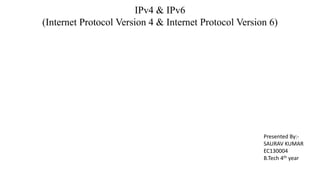
IPv4 and IPv6
- 1. IPv4 & IPv6 (Internet Protocol Version 4 & Internet Protocol Version 6) Presented By:- SAURAV KUMAR EC130004 B.Tech 4th year
- 2. CONTENT Introduction IPv4 (Internet Protocol Version 4) IPv4 Addressing IPv6 ( Internet Protocol Version 6) IPv6 Addressing Difference between IPv4 & IPv6
- 3. Introduction History In 1978,the office of the Secretary of Defense (OSD) mandated the use of IPv4 for all “host-to-host” data exchange enabling IPv4 to become the mechanism for the military to create integrated versus solved piped communications. What is IP (Internet Protocol) ? The Internet Protocol (IP) is the method or protocol by which data is sent from one computer to another on the internet. E.g..- 172.27.176.126 What is IP (Internet Protocol) address? An IP address is an identifier for a particular machine on a particular network. It is part of a scheme to identify computer on the internet. IP address is also referred to as IP number and internet address.
- 4. IPv4 ( Internet Protocol Version 4) • IPv4 ( Internet Protocol Version 4) is the fourth version of the Internet Protocol (IP). It is one of the core protocols of standard based internetworking methods in the Internet. • IPv4 is a connectionless protocol for use on packet-switched networks. • This IP address consist of 2 component the network id and the host id. • IPv4 allows 2³² (4,294,967,296) unique address which section of IP address show the network id & which section show the machine or host it depend on the class network.
- 5. IPv4 Addressing There are Five classes of IP addresses:- 1. Class A 2. Class B 3. Class C 4. Class D 5. Class E
- 6. IPv4 classes Class A :- • The first byte is a network id (8 bits) & the last 3 bytes are for host id 24 bits). • The first bit is ‘0’. • Range of network number- 1.0.0.0 to 126.0.0.0 • Number of possible networks- 127(1-126usable, 127 is reserved) • Number of possible values in the host portion -16,777,216 • It is used for large network. Class B :- • The first 2 bytes are a network id (16 bits) & the last 2 bytes are for host id ( 16 bits). • The first 2 bits are ‘10’. • Range of network number – 128.0.0.0 to 191.255.0.0 • Number of possible networks- 16,384. • Number of possible values in the host portion- 65536 • Used for medium size network.
- 7. Class C :- • The first 3 bytes are a network id (24 bits) & the last 1 byte are for host id (8 bit). • The first 3 bits are ‘110’. • Range of network number- 192.0.0.0 to 223.255.255.0 • Number of possible networks – 2,097,152 • Number of possible values in the host portion – 256 • Used in local area network(LAN). Class D :- • An IP address which belong to class D has the first octet has its 4bit set to ‘1110’. • Range of network number – 224.0.0.0 to 239.255.255.255 • Used for multicasting. Class E :- • It reserved for experimental & for future testing purpose. • Range of network number- 240.0.0.0 to 255.255.255.254. IPv4 classes contd...
- 8. IPv6 (Internet Protocol Version 6) • Larger Address Space • Aggregation-based address hierarchy • Efficient backbone routing • Efficient and Extensible IP datagram • Stateless Address Autoconfiguration • Security (IPsec mandatory) • Mobility
- 9. IPv6 Addressing IPv6 addresses are 128-bits identifiers for interfaces and sets of interfaces. There are three types of addresses: • Unicast: An identifier for a single interface. A pack sent to an unicast address is delivered to the interface identified by that address. • Anycast: An identifier for a set of interfaces (typically belonging to different nodes). A packets sent to an anycast address is delivered to one of the interfaces identified by that address (the “nearest one, according to the routing protocols’ measure of the distance). • Multicast: An identifier for a set of interfaces (typically belonging to different nodes). A packets sent to a multicast address is delivered to all interfaces identified by that address.
- 10. S.N IPv4 IPv6 1. Addresses are 32bits (4 bytes) long. Addresses are 128bits (416bytes) long. 2. Header include a checksum. Header doesn’t support a checksum. 3. Configuration either manually or through DHCP. Doesn’t required manual configuration 4. Must support a 576bytes packet size Must support 1208bytes packet size. 5. Not suitable for mobile networks. IPv6 is better suited to mobile networks. 6. Address space is small. Larger address space 7. Internet protocol security(IPSec) is mandatory in this. IPSec is optional. Difference between IPv4 & IPv6
